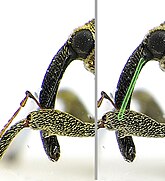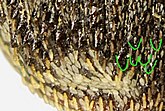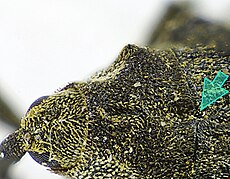Grained nettle weevil
| Grained nettle weevil | ||||||||||||
|---|---|---|---|---|---|---|---|---|---|---|---|---|

Grained nettle weevil ( Parethelcus pollinarius ) |
||||||||||||
| Systematics | ||||||||||||
|
||||||||||||
| Scientific name | ||||||||||||
| Parethelcus pollinarius | ||||||||||||
| ( Forster , 1771) |
The grained nettle weevil ( Parethelcus pollinarius , syn .: Ceutorhynchus pollinarius ) is a beetle from the family of weevils . With an average of three to four millimeters in length, it is somewhat larger than the nettle weevil Nedyus quadrimaculatus , which also lives monophag on the nettle, and lives less socially than this. The animal has many synonyms.

|

|

|
| Fig. 1: top | Fig. 2: side | |

|
||
| Fig. 3: Front | Fig. 4: underside | Fig. 5: Trunk, side view of the sensor pit on the right, tinted green |

|
||
| Fig. 7: Wing covers from the rear right partially colored: ocher: edge of the right wing cover yellow: field of light scales on the fall, green: fall edge with a band of rasp teeth |
||
| Fig. 6: Detail of the pronotum from diagonally above (head on the left, green arrowhead points to the label ) |
||

|

|
|
| Fig. 8: Section 9. Interval of the wing covers (optical side edge when viewed from above) with rasp bumps, at the tip of which a short bristle rises (a bump with a bristle outlined in green) |
Fig. 9: Top of the left wing cover from above , area with rasp teeth (the outline of some of them traced in green) |
|
Comments on the name and the system
It was first described by Forster in 1771 under the name Curculio pollinarius . The detailed Latin description contains the section: venter, pedes & elytrorum margines aspersi polline griseo creberrimo ( Latin: belly legs and the edges of the elytra are covered with dense gray (flower) dust ). This explains the species name pollinārius .
The generic name Parethelcus is from the generic name Ethelcus and old Gr. παρά, pará, “next to” derived and contains part of the species that belonged to the subgenus Ethelcus created by Reitter . The genus is traditionally a subgenus of Ceutorhynchus .
The genus Parethelcus consists of only two species, the occurrence of the other species Parethelcus nesicola being limited to the Canary Islands .
Characteristics of the beetle
The body is rounded, the top flatter than the bottom. Except for the brownish tarsi and antennae, it is black in color. However, it is covered with dirty white scales in such a way that it appears cloudy and blotchy without any distinctive markings (Fig. 1). In particular, the wing covers are marbled above with fuzzy gray nebulae. The shape of the scales varies from leaflets to pencils (easily recognizable in Fig. 6).
The most striking thing about the head is the trunk. It is long and slender and moderately curved inward. In the resting position, it can be placed on the underside of the body between the front hips. In the case of the grained nettle weevil, however, the recess for this is not exactly angular and glossy black, but rounded and lined with scales (Fig. 4).
The antennae are in the front third of the trunk, in the females a little further back than in the males. The first antenna element (shaft) is very slim and slightly widened towards the tip. The shaft can be inserted precisely into the sensor pit. This begins at the deflection point of the feelers and then runs slightly down the side of the trunk in a straight line. It disappears before the eyes (Fig. 5, sensor pit in the duplicate on the right with a green background). The shaft does not reach the eyes. The seven members of the antenna whip following the shaft and the three-part club are bent forward by 180 ° in the rest position. The club is elongated and pointed.
The eyes standing to the side of the trunk base are about a trunk width apart. Accordingly, the base of the trunk between the eyes is slightly narrowed (Fig. 2). The eyes are almost circular and slightly protruding. They do not reach the lower edge of the trunk (Fig. 3 and Fig. 5).
The pronotum has a central furrow that is trough-shaped in the basal area, flatter in the front area and only weakly developed in between. (Fig. 6). In the basal third there is a strong hump on each side, in front of which the pronotum is indented laterally (Fig. 6). It tapers towards the front to almost the width of the head. The front edge of the pronotum (collar) is raised and double-edged (clearly visible in Fig. 3 at full resolution). The pronotum is strong and densely punctured .
The elytra are flat and have weakly indented dot stripes. The shoulders are distinctive. The edges of the elytra are strongly turned under, so the side edge of the elytra is not visible from above. Viewed from above, the ninth space between the wing covers forms the outer edge of the wing covers. Compared to the eighth space, it is slightly lower in level. It is conspicuously structured over the entire length with striking black, shiny rasp bumps. Each hump has a short, thick, black bristle. The eighth space therefore appears darker and more uneven, while the neighboring spaces are flat and matt (Fig. 8). At the rear edge, the wing covers drop off steeply (wing cover crash). At the edge of the wing cover fall, the wing covers are provided with a band of many tooth-like cusps (rasp cusps) (Fig. 6, on the right with a green background). Between the fall and the rear edge of the wing there is a light scaly spot (Fig. 7, marked yellow on the right). At the rear end, the wings are individually rounded (Fig. 7, drawn as an ocher line on the right).
The label (Fig. 6, directly in front of the tip of the blue arrow) is barely visible. Around the label, the rear edge of the neck shield, the wing covers and the wing cover seam are lowered to form a pit.
The chitin plates (epimers) that adjoin the mid-breast laterally rise up on the sides of the body and form a triangle between the posterior edge of the cervical shield and the wing coverts (clearly visible in Fig. 2 at a higher resolution). From above they are not or hardly visible, while this is quite common with the other species of the subfamily.
The legs are long and strong. All legs have a strong, blunt tooth on the underside (easy to see in Fig. 3 on the left). The front rails end without a spike or tooth. The middle and rear rails are also unborn in the female, but in the male they have a small thorn on the inside at the end. The tarsi are four-limbed, the third limb clearly lobed. The claw link is long and ends in a toothed claw.
biology
The moisture-loving species is found preferentially in shady places, on the edges of forests, on northern slopes, on moist meadows and on the edges of ditches. The beetle only occurs in exceptional cases on ruderal areas and on fields. In winter the beetle can be found sporadically in leaves, detritus and genist.
The monophage beetle is usually found singly or in pairs on nettles or neighboring plants. When disturbed, he puts on legs and trunk, rolls to the ground and remains there immobile. It then resembles a crumb of earth.
The larva feeds on a monophagous diet and develops in the leaves and stems of the nettle. Pupation takes place in the ground. The hatched animals appear at the end of August. They overwinter at a shallow depth in the ground. In the next year, they appear from mid-May to July and mate and lay eggs.
distribution
The species occurs in Europe, Africa and Asia. In Central Europe it is distributed vertically up to heights of over a thousand meters. It prefers moist terrain, ditch edges, north or east facing locations, partially shaded locations. It is tied to the range of the nettle. In the places where the beetle appears, it is usually not uncommon.
literature
- Heinz joy , Karl Wilhelm Harde , Gustav Adolf Lohse (ed.): The beetles of Central Europe . tape 11 . Rhynchophora (end). Goecke & Evers, Krefeld 1983, ISBN 3-87263-031-8 .
- G. Jäger (Ed.): CG Calwer 's Käferbuch. 3. Edition. K. Thienemanns, Stuttgart 1876.
- Klaus Koch : The Beetles of Central Europe . Ed .: Heinz Freude . tape 3 : ecology . Goecke & Evers, Krefeld 1992, ISBN 3-87263-042-3 , pp. 327 .
Web links
Individual evidence
- ↑ a b https://fauna-eu.org/cdm_dataportal/taxon/769d2b4c-2003-44f3-8a31-9def420fa051
- ↑ JR Forster: Novæ species insectorum. Centuria I London 1771. (Davies, White). P. 33. No. 33
- ↑ Edmund Reitter : Fauna Germanica, the beetles of the German Empire , Volume 5, KGLutz 'Verlag, Stuttgart 1916 p. 152
- ^ Parethelcus in Fauna Europaea. Retrieved March 16, 2013
- ↑ Species of the genus Parethelcus at BioLib
- ↑ Parethelcus nesicola at Fauna Europaea. Retrieved March 16, 2013
- ↑ English species description
- ↑ Hans Wagner: About collecting Ceuthorrhynchinen from the practice of the beetle collector as PDF

